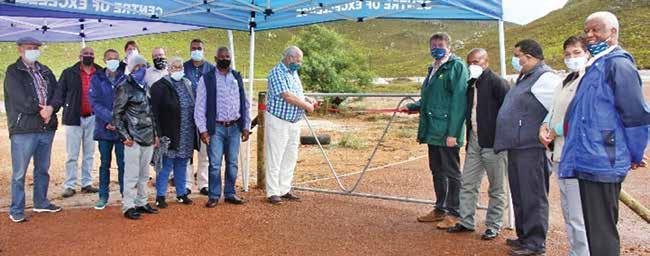18
www.thevillagenews.co.za
24 March 2021
MY ENVIRONMENT
The elusive caracal By Dr Anina Lee
of Lynxes roughly 10 million years ago. In fact, the caracal’s closest relative is the African Golden Cat, followed by the Serval – another beautiful spotted cat. Caracals stand just under half a metre tall and weigh between 10 and 15 kg. Caracals are the second largest predator in the Overberg after Cape Leopards.
O
n 25 February 2021, a caracal was fatally injured by a speeding motorist on the R43 near the Green House in Vermont. It was desperately sad and so unneces-
sary.
On his way to work, a member of the public spotted the caracal lying on the side of the road. He stopped to see if he could help. The cat tried to move away, but it stumbled into the bushes with great difficulty. It was evident that it was seriously hurt. The caracal was sedated in the field by Dr Melinda Devenish from Village Vet Clinic, Eastcliff for transport to Onrus Veterinary Clinic. The caracal was a female. She was X-rayed and found to be critically injured. She had a cervical fracture, with damage to the spinal cord and severe lung contusions. After consultation between attending vets, the difficult decision was taken to euthanise her. Her stomach was full of food, as evidenced by many prey bones seen on the X-ray. She had been a fine and successful hunter. Meredith Thornton arranged for the caracal to be frozen overnight and transported to the Urban Caracal Project at UCT, where a necropsy will be performed. Meredith will take samples for corticosteroid analyses for her work with the Mammal Research Institute, University of Pretoria. The UCT team will take fur and whiskers for isotope analysis, check what is in the stomach, sample organs, check reproductive hormones and other chemical analyses. At least the caracal’s death will not be totally in vain. But it was avoidable. The Overstrand is a place where we are still privileged to live close to nature. It is our responsibility to care for it. Wildlife will cross roads, especially at night. It is up to us to drive carefully, at a speed that makes it possible to avoid animals (and indeed people) on the road. A magnificent animal like a caracal is to be cherished. This incident once again demonstrated the care, compassion and willingness to assist wildlife by our local veterinarians. They are a special band of people. Caracals (Caracal caracal) are beautiful cats, with reddish-tan coats and lighter undersides with red spots. The Afrikaans name ‘Rooikat’ is especially descriptive of the cats. They have beautifully patterned faces with markings of black and white. They are sometimes called lynxes, but they are not true lynxes. The evolution of the Caracal branch of cats split from that
The most distinctive feature of a caracal is its ears. Each ear has 20 muscles that can move the ears independently to receive sounds from all around it. They act a bit like satellite dishes, focusing the sound waves towards the ears. The ears are dark in colour and proportionately large, with long black tufts at the tips. These hairy extensions are thought to improve hearing further. So prominent are the black tips that they were originally named for their ears. Caracal comes from the Turkish word ‘karakulak’, meaning ‘black ear’. Since the name originated in Turkey, one would expect that caracals are found in the Middle East. So they are – as well as in Central Africa, South Africa, West Africa and Southwest Asia. Apparently, the saying “Putting the cat amongst the pigeons” stems from an old middle eastern practice of putting a caracal in an arena with a flock of pigeons and taking bets on how many the caracal can catch once it is released. It would have been many, as caracals are excellent hunters and can jump three metres straight up into the air to catch birds in mid-flight. But despite their aerial prowess, caracals are mainly ambush predators and prefer to hunt by stealth and at night. The nocturnal habit is partially to avoid humans – many of whom are intent on eradicating these beautiful creatures. Farmlands are increasingly intruding on wildlife territory, reducing the numbers of their prey species. Caracals would usually hunt antelope such as young springbok, grysbok and duiker, and birds, rodents and even reptiles. But as human encroachment reduces their prey, caracals have to hunt farm animals to survive. It is easy to see how conflict with humans arises, even though the cats do not initiate the conflict. Caracals are solitary cats, except during mating and when mothers raise their kittens. The average caracal litter is two kittens that stay with the mother for up to a year. We don’t always see wildlife like these elusive cats but be assured they are around. The Urban Caracal Project in Cape Town has proved that with their remote camera monitoring projects. Caracals are not formally protected in Africa, but that does not mean that we should not protect them – and all the other fantastic wildlife we are still privileged to have here in the Overberg. Every animal is an integral part of a delicate ecosystem. The loss of one part of that system can mean the loss of the whole. Let it not happen on our watch.
ABOVE: As human encroachment on wildlife territory reduces the caracal’s prey species, they often have to hunt farm animals to survive. PHOTO: Wikipedia LEFT: Caracals (Caracal caracal) are gorgeous cats, with reddish-tan coats and lighter undersides with red spots. They have beautifully patterned faces with markings of black and white. PHOTO: National Geographic BELOW: A caracal mother and kitten. The average caracal litter is two kittens that stay with the mother for up to a year. PHOTO: HowStuffWorks




















